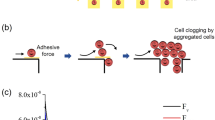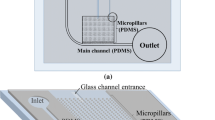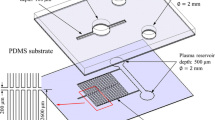Abstract
Evaluation and diagnosis of blood alterations is a common request for clinical laboratories, requiring a complex technological approach and dedication of health resources. In this paper, we present a microfluidic device that owing to a novel combination of hydrodynamic and dielectrophoretic techniques can separate plasma from fresh blood in a microfluidic channel and for the first time allows optical real-time monitoring of the components of plasma without pre- or post-processing. The microchannel is based on a set of dead-end branches at each side and is initially filled using capillary forces with a 2-μL droplet of fresh blood. During this process, stagnation zones are generated at the dead-end branches and some red blood cells (RBCs) are trapped there. An electric field is then applied and dielectrophoretic trapping of RBCs is used to prevent more RBCs entering into the channel, which works like a sieve. Besides, an electroosmotic flow is generated to sweep the rest of the RBCs from the central part of the channel. Consequently, an RBC-free zone of plasma is formed in the middle of the channel, allowing real-time monitoring of the platelet behavior. To study the generation of stagnation zones and to ensure RBC trapping in the initial constrictions, two numerical models were solved. The proposed experimental design separates up to 0.1 μL blood plasma from a 2-μL fresh human blood droplet. In this study, a plasma purity of 99 % was achieved after 7 min, according to the measurements taken by image analysis.

Schematics of a real-time plasma monitoring system based on a Hydrodynamic and direct-current insulator-based dielectrophoresis microfluidic channel









Similar content being viewed by others
Abbreviations
- DC:
-
Direct current
- DEP:
-
Dielectrophoresis
- EOF:
-
Electroosmotic flow
- EP:
-
Electrophoresis
- RBC:
-
Red blood cell
References
Okorie UM, Diamond SL (2006) Matrix protein microarrays for spatially and compositionally controlled microspot thrombosis under laminar flow. Biophys J 91:3474–3481
De Witt SM, Swieringa F, Cavill R, Lamers MME, Kruchten RV, Mastenbroek T, Baaten C, Coort S, Pugh N, Schulz A, Scharrer I, Jurk K, Zieger B, Clemetson KJ, Farndale RW, Heemskerk JWM, Cosemans JMEM (2014) Identification of platelet function defects by multi-parameter assessment of thrombus formation. Nat Commun 5:4257
Lenshof A, Laurell T (2010) Continuous separation of cells and particles in microfluidic systems. Chem Soc Rev 39:1203–1217
Sajeesh P, Sen AK (2014) Particle separation and sorting in microfluidic devices: a review. Microfluid Nanofluid 17:1–52
Hou HW, Bhagat AA, Lee WC, Sha Huang S, Han J, Lim CT (2011) Microfluidic devices for blood fractionation. Micromachines 2:319–343
Kerhoas MK, Sollier E (2013) Micro-scale blood heparinized plasma separation: from acoustophoresis to egg-beaters. Lab Chip 13:3323–3346
Songjaroen T, Dungchai W, Chailapakul O, Henry CS, Laiwattanapaisal W (2012) Blood separation on microfluidic paper-based analytical devices. Lab Chip 12:3392–3398
Yang X, Forouzan O, Brown TP, Shevkoplyas SS (2012) Integrated separation of blood plasma from whole blood for microfluidic paper-based analytical devices. Lab Chip 12:274–280
Wu CC, Hong LZ, Ou CT (2012) Blood cell-free of plasma separated from blood samples with a cascading weir-type microfilter using dead-end filtration. J Med Biol Eng 32:163–168
Crowley TA, Pizziconi V (2005) Isolation of plasma from whole blood using planar microfilters for lab-on-a-chip applications. Lab Chip 5:922–929
Karimi A, Yazdi S, Ardekani AM (2013) Hydrodynamic mechanisms of cell and particle trapping in microfluidics. Biomicrofluidics 7:021501–021522
Sollier E, Go DE, Che J, Gossett DR, Sean O'Byrne S, Weaver WM, Kummer N, Rettig M, Goldman J, Nickols N, McCloskey S, Kulkarni RP, Carlo DD (2014) Size-selective collection of circulating tumor cells using Vortex technology. Lab Chip 14:63–77
Jubery TZ, Srivastava SK, Dutta P (2014) Dielectrophoretic separation of bioparticles in microdevices: a review. Electrophoresis 35:691–713
Lewpiriyawong N, Yang C (2014) Dielectrophoresis field-flow fractionation for continuous-flow separation of particles and cells in microfluidic devices. Adv Transp Phenom 3:29–62
Srivastava SK, Cardiel JB, Encinas BL, Minerick AR (2011) A continuous DC-insulator dielectrophoretic sorter of microparticles. J Chromatogr A 1218:1780–1789
Qian C, Huang H, Chen L, Li X, Ge Z, Chen T, Yang Z, Sun L (2014) Dielectrophoresis for bioparticle manipulation. Int J Mol Sci 15:18281–18309
Gao J, Yin XF, Fang ZL (2004) Integration of single cell injection, cell lysis, separation and detection of intracellular constituents on a microfluidic chip. Lab Chip 4:47–52
Brown R, Audet J (2008) Current techniques for single-cell lysis. J R Soc Interface 5:131–138
Lapizco-Encinas BL, Simmons BA, Cummings EB, Fintschenko Y (2004) Dielectrophoretic concentration and separation of live and dead bacteria in an array of insulators. Anal Chem 76:1571–1579
Cho YK, Kim S, Lee K, Park C, Lee JG, Ko C (2009) Bacteria concentration using a membrane type insulator-based dielectrophoresis in a plastic chip. Electrophoresis 30:3153–3159
Kang Y, Li D, Kalams S, Eid J (2008) DC-dielectrophoretic separation of biological cells by size. Biomed Microdevices 10:243–249
Srivastava S, Artemiou A, Minerick A (2011) Direct current insulator-based dielectrophoretic characterization of erythrocytes: ABO-Rh human blood typing. Electrophoresis 32:2530–2540
Jones P, Staton S, Hayes M (2011) Blood cell capture in a sawtooth dielectrophoretic microchannel. Anal Bioanal Chem 401:2103–2111
Srivastava S, Gencoglu A, Minerick A (2011) DC insulator dielectrophoretic applications in microdevice technology: a review. Anal Bioanal Chem 399:301–321
Cardiel JB, Encinas BL, Betanzo CR, Santoscoy AC, Chapa SM (2009) Prediction of trapping zones in an insulator-based dielectrophoretic device. Lab Chip 9:2896–2901
Kirby B (2010) Micro- and nanoscale fluid mechanics transport in microfluidic devices. Cambridge University Press, New York
Chaoco SO, Encinas BL, Palomares MR, Chapa SM, Betanzo CR (2008) Performance characterization of an insulator-based dielectrophoretic microdivice. Electrophoresis 29:3115–3122
Kwon JS, Maeng JS, Chun MS, Song S (2008) Improvement of microchannel geometry subject to electrokinesis and dielectrophoresis using numerical simulations. Microfluid Nanofluid 5:23–31
Villanueva RG, Sano M, Encinas BL, Davalos R (2014) Joule heating effects on particle immobilization in insulator-based dielectrophoretic devices. Electrophoresis 35:352–361
Chan WY, Ding Y, Tu JY (2007) Modeling of non-Newtonian blood flow through a stenosed artery incorporating fluid-structure interaction. ANZIAM J 47:507–523
Johnston B, Johnston P, Corney S, Kilpatrick D (2004) Non-Newtonian blood flow in human right coronary arteries: steady state simulations. J Biomech 37:709–720
Acknowledgments
The authors gratefully thank Dr. Roberto Castilla López for reading the manuscript and his valuable help regarding hydrodynamic simulation. The project has been funded by BIOPAPμFLUID CTQ2013-48995-C2-1-R of Ministerio de Economia y Competitividad of Spain.
Author information
Authors and Affiliations
Corresponding author
Rights and permissions
About this article
Cite this article
Mohammadi, M., Madadi, H., Casals-Terré, J. et al. Hydrodynamic and direct-current insulator-based dielectrophoresis (H-DC-iDEP) microfluidic blood plasma separation. Anal Bioanal Chem 407, 4733–4744 (2015). https://doi.org/10.1007/s00216-015-8678-2
Received:
Revised:
Accepted:
Published:
Issue Date:
DOI: https://doi.org/10.1007/s00216-015-8678-2




